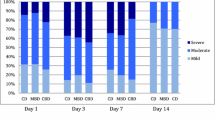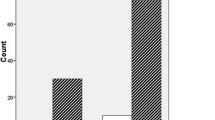Abstract
Purpose
Tonsillectomy is among the most common surgical procedures performed worldwide, and post-tonsillectomy bleeding is a serious complication. This study aims to investigate the role of post-operative pain as a risk factor for bleeding in adults.
Methods
A retrospective cohort study of adults who underwent tonsillectomy in a tertiary referral center between 2015–2021. Medical records were reviewed for demographics, diagnoses, surgical technique, treatments, pain scores (measured by visual analogue scale 0–10), readmissions, and bleeding events. The primary outcome was return to the operating room for hemostasis, and secondary outcomes were bleeding events and consumption of additional analgesic doses.
Results
Of the 274 patients, 137 (50%) were males, the mean age was 30.3 ± 12 years (range 18–82), and 33 (12%) were smokers. Indications for tonsillectomy were recurrent throat infections in 213 (77.7%) patients and obstructive sleep apnea in 61 (22.3%). Surgical technique was cold dissection in 238 (86.9%) patients and electrocautery in 36 (13.1%). Primary post-tonsillectomy bleeding (< 24 h of surgery) occurred in 6 (2%) patients, and secondary bleeding (later than 24 h from tonsillectomy) in 43 (15.7%). A total of 19 (7%) patients necessitated surgical hemostasis. After controlling for technique and other confounders, high pain scores (VAS ≥ 5) on post-operative days 1 and 2 were associated with increased risk of bleeding that necessitated surgical hemostasis (adjusted odds ratio 6.9, 95% confidence interval 1.7–44.5). Other independent risk factors were male sex, age < 30 years, smoking, and recurrent throat infections.
Conclusions
Higher pain scores following tonsillectomy are correlated with bleeding episodes requiring surgical intervention in adults. Further studies may explore the role of different intensive pain regimens in minimizing the risk of bleeding.

Similar content being viewed by others
Data availability statement
Data generated/analyzed in this study will be made available to researchers upon reasonable request to the corresponding author.
References
Margaret JH, Alexander S, Jin Z, Xiang L (2017) Ambulatory surgery data from Hospitals and Ambulatory Surgery Centers: United States. 2017, National Health Statistics Report. Accessed 7 Oct 2022
Mitchell RB, Archer SM, Ishman SL, Rosenfeld RM, Coles S, Finestone SA, Friedman NR, Giordano T, Hildrew DM, Kim TW, Lloyd RM, Parikh SR, Shulman ST, Walner DL, Walsh SA, Nnacheta LC (2019) Clinical practice guideline: tonsillectomy in children (update). Otolaryngol Head Neck Surg 160(1_suppl):S1–S42. https://doi.org/10.1177/0194599818801757
Dhaduk N, Rodgers A, Govindan A, Kalyoussef E (2021) Post-tonsillectomy bleeding: a national perspective. Ann Otol Rhinol Laryngol 130(8):941–947. https://doi.org/10.1177/0003489420987438. (Epub 2021 Jan 13)
De Luca CG, Pachêco-Pereira C, Aydinoz S, Bhattacharjee R, Tan HL, Kheirandish-Gozal L, Flores-Mir C, Gozal D (2015) Adenotonsillectomy complications: a meta-analysis. Pediatrics 136(4):702–718. https://doi.org/10.1542/peds.2015-1283. (Epub 2015 Sep 21)
Gross JH, Lindburg M, Kallogjeri D, Molter M, Molter D, Lieu JEC (2021) Predictors of occurrence and timing of post-tonsillectomy hemorrhage: a case-control study. Ann Otol Rhinol Laryngol 130(7):825–832. https://doi.org/10.1177/0003489420978010. (Epub 2020 Dec 8)
Inuzuka Y, Mizutari K, Kamide D, Sato M, Shiotani A (2020) Risk factors of post-tonsillectomy hemorrhage in adults. Laryngoscope Investig Otolaryngol 5(6):1056–1062. Published 2020 Nov 14. https://doi.org/10.1002/lio2.488
Ikoma R, Sakane S, Niwa K, Kanetaka S, Kawano T, Oridate N (2014) Risk factors for post-tonsillectomy hemorrhage. Auris Nasus Larynx 41(4):376–379. https://doi.org/10.1016/j.anl.2014.02.007. (Epub 2014 Mar 3)
Cinamon U, Goldfarb A, Marom T (2017) The impact of tobacco smoking upon chronic/recurrent tonsillitis and post tonsillectomy bleeding. Int Arch Otorhinolaryngol 21(2):165–170. https://doi.org/10.1055/s-0036-1593835. (Epub 2016 Oct 26)
Seyhun N, Dizdar SK, Çoktur A, Bektaş ME, Albuz O, Erol ZN, Turgut S (2020) Risk factors for posttonsillectomy hemorrhage in adult population: does smoking history have an impact? Am J Otolaryngol 41(1):102341. https://doi.org/10.1016/j.amjoto.2019.102341. (Epub 2019 Nov 6)
Coordes A, Soudry J, Hofmann VM, Lenarz M (2016) Gender-specific risk factors in post-tonsillectomy hemorrhage. Eur Arch Otorhinolaryngol 273(12):4535–4541. https://doi.org/10.1007/s00405-016-4146-7. (Epub 2016 Jun 21)
Blanchford H, Lowe D (2013) Cold versus hot tonsillectomy: state of the art and recommendations. ORL J Otorhinolaryngol Relat Spec 75(3):136–141. https://doi.org/10.1159/000342315. (Epub 2013 Aug 22)
Lowe D, van der Meulen J, National Prospective Tonsillectomy Audit (2004) Tonsillectomy technique as a risk factor for postoperative haemorrhage. Lancet 364(9435):697–702. https://doi.org/10.1016/S0140-6736(04)16896-7
Leinbach RF, Markwell SJ, Colliver JA, Lin SY (2003) Hot versus cold tonsillectomy: a systematic review of the literature. Otolaryngol Head Neck Surg 129(4):360–364. https://doi.org/10.1016/s0194-5998(03)00729-0
Galindo Torres BP, De Miguel GF, Whyte OJ (2018) Tonsillectomy in adults: analysis of indications and complications. Auris Nasus Larynx 45(3):517–521. https://doi.org/10.1016/j.anl.2017.08.012. (Epub 2017 Sep 18)
Francis DO, Fonnesbeck C, Sathe N, McPheeters M, Krishnaswami S, Chinnadurai S (2017) Postoperative bleeding and associated utilization following tonsillectomy in children. Otolaryngol Head Neck Surg 156(3):442–455. https://doi.org/10.1177/0194599816683915. (Epub 2017 Jan 17)
Riggin L, Ramakrishna J, Sommer DD, Koren G (2013) A 2013 updated systematic review & meta-analysis of 36 randomized controlled trials; no apparent effects of non steroidal anti-inflammatory agents on the risk of bleeding after tonsillectomy. Clin Otolaryngol 38(2):115–129. https://doi.org/10.1111/coa.12106
Lewis SR, Nicholson A, Cardwell ME, Siviter G, Smith AF (2013) Nonsteroidal anti-inflammatory drugs and perioperative bleeding in paediatric tonsillectomy. Cochrane Database Syst Rev 2013(7):CD003591. https://doi.org/10.1002/14651858.CD003591.pub3
Elbadawey MR, Hegazy HM, Eltahan AE, Powell J (2015) A randomised controlled trial of coblation, diode laser and cold dissection in paediatric tonsillectomy. J Laryngol Otol 129(11):1058–1063. https://doi.org/10.1017/S0022215115002376. (Epub 2015 Sep 18)
Wang J, Liu D, Huang Z, Zhong J, Tan Z, Qiu S (2009) Low-temperature coblation-assisted versus conventional dissection tonsillectomy in surgeries for children. J Otolaryngol Head Neck Surg 23(15):690–692
Paramasivan VK, Arumugam SV, Kameswaran M (2012) Randomized comparative study of adenotonsillectomy by conventional and coblation method for children with obstructive sleep apnea. Int J Pediatr Otorhinolaryngol 76(6):816–821. https://doi.org/10.1016/j.ijporl.2012.02.049. (Epub 2012 Mar 18)
Stoker KE, Don DM, Kang DR, Haupert MS, Magit A, Madgy DN (2004) Pediatric total tonsillectomy using coblation compared to conventional electrosurgery: a prospective, controlled single-blind study. Otolaryngol Head Neck Surg 130(6):666–675. https://doi.org/10.1016/j.otohns.2004.02.012
Parker D, Howe L, Unsworth V, Hilliam R (2009) A randomised controlled trial to compare postoperative pain in children undergoing tonsillectomy using cold steel dissection with bipolar haemostasis versus coblation technique. Clin Otolaryngol 34(3):225–231. https://doi.org/10.1111/j.1749-4486.2009.01932.x
Sarny S, Habermann W, Ossimitz G, Stammberger H (2012) Significant post-tonsillectomy pain is associated with increased risk of hemorrhage. Ann Otol Rhinol Laryngol 121(12):776–781. https://doi.org/10.1177/000348941212101202
Vanderwall AG, Milligan ED (2019) Cytokines in pain: harnessing endogenous anti-inflammatory signaling for improved pain management. Front Immunol 10:3009. https://doi.org/10.3389/fimmu.2019.03009
Roberts HR, Monroe DM, Escobar MA (2004) Current concepts of hemostasis: implications for therapy. Anesthesiology 100(3):722–730. https://doi.org/10.1097/00000542-200403000-00036
Bijur PE, Silver W, Gallagher EJ (2001) Reliability of the visual analog scale for measurement of acute pain. Acad Emerg Med 8(12):1153–1157. https://doi.org/10.1111/j.1553-2712.2001.tb01132.x
Karcioglu O, Topacoglu H, Dikme O, Dikme O (2018) A systematic review of the pain scales in adults: which to use? Am J Emerg Med 36(4):707–714. https://doi.org/10.1016/j.ajem.2018.01.008. (Epub 2018 Jan 6)
Na’ara S, Aronov M, Gil Z, Gordin A (2021) Can tonsillectomy be safely performed by residents? A comparative retrospective study. Ann Otol Rhinol Laryngol 130(12):1340–1344. https://doi.org/10.1177/00034894211007057. (Epub 2021 Apr 7)
Funding
No funds, grants, or other support was received for conducting this study.
Author information
Authors and Affiliations
Contributions
RN: design, conduct, data collection, analysis, drafting the manuscript; DO: design, drafting the manuscript; YS: design, analysis, drafting the manuscript.
Corresponding author
Ethics declarations
Conflict of interest
The authors declare no potential conflict of interest. The authors have no relevant financial or non-financial interests to disclose.
Ethics approval statement
This study was approved by the Institutional Review Board of the Rambam healthcare campus (0403-21-RMB-D).
Patient consent statement
Not required.
Additional information
Publisher's Note
Springer Nature remains neutral with regard to jurisdictional claims in published maps and institutional affiliations.
The manuscript was written and edited under The Strengthening the Reporting of Observational Studies in Epidemiology (STROBE) guideline for reporting cohort studies.
Supplementary Information
Below is the link to the electronic supplementary material.
Rights and permissions
Springer Nature or its licensor (e.g. a society or other partner) holds exclusive rights to this article under a publishing agreement with the author(s) or other rightsholder(s); author self-archiving of the accepted manuscript version of this article is solely governed by the terms of such publishing agreement and applicable law.
About this article
Cite this article
Noy, R., Ostrovsky, D. & Shkedy, Y. Adult tonsillectomy—increased pain scores are correlated with risk of bleeding: a retrospective cohort study. Eur Arch Otorhinolaryngol 280, 3437–3444 (2023). https://doi.org/10.1007/s00405-023-07931-z
Received:
Accepted:
Published:
Issue Date:
DOI: https://doi.org/10.1007/s00405-023-07931-z




